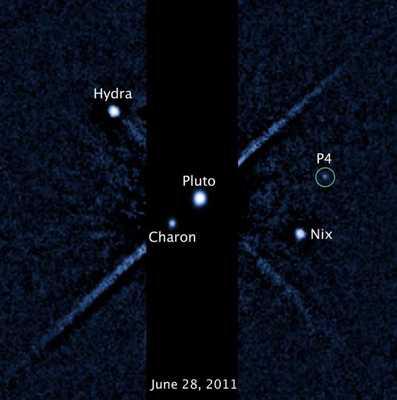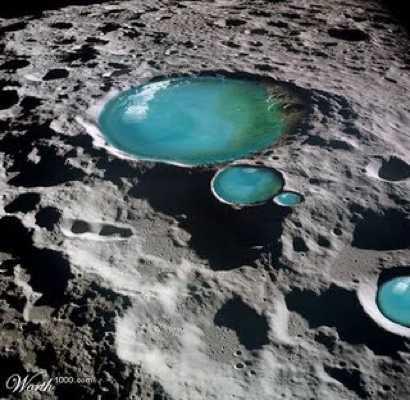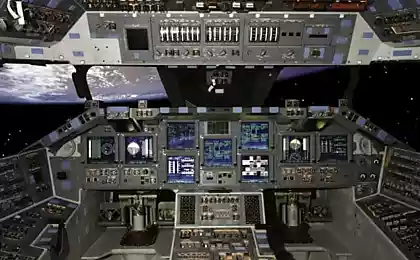742
10 latest discoveries in space
(according to the list Teresa Cornelius)
The more developed modern technology, the more opportunities open to learning more about our universe. Lately it has become possible to confirm the facts of the universe, which previously we could only guess. Here is a list of some of the recent discoveries in space. Enjoy!
Accomplish your goal to end
source
10. A new Pluto (P4)
We now know that Pluto revolves around four satellites.
Charon was discovered in 1978 and is the largest of the moons of Pluto. Its diameter, on current estimates, is 1205 km - slightly more than half the diameter of Pluto, and the weight ratio is 1: 8. For comparison, the ratio of the mass of the Moon and the Earth is equal to 1:81. Because such a small ratio of the mass of Pluto, Charon, and are often seen as a double dwarf planet. In 2005, the Hubble Space Telescope has discovered 2 satellites of Pluto - nobody Hydra. Presumably diameter of no one - 46 km and the Hydra - 61 km.
The discovery of Pluto's satellite occurred in 2011 when Hubble photographed celestial body that temporarily called P4. Its dimensions are 13 to 34 km. How amazing that the Hubble photographed the tiny body is located at a distance of more than 3 billion kilometers from us!

9. giant cosmic magnetic bubbles
NASA launched two space probes Voyager for exploring the border region of the heliosphere, at a distance of about 9 billion kilometers from Earth. Contrary formed over fifty years of speculation, observers were on the edge of the solar system is not linear and gradually decreasing magnetic field, and a boiling froth of locally magnetised regions stretching hundreds of millions of kilometers each - mobile cellular structure within which the magnetic field lines are constantly broken, recombined and form a new field - the magnetic "bubbles".

8. Not only is the tail of a comet
Specialists NASA, working with the scientific satellite GALEX, in 2007, reported a surprising discovery. The star, named after the "amazing" - Mira, fully lives up to its name. Made GALEX ultraviolet images revealed that the stars in the constellation Cetus, not just flying through space at great speed, but also reserves the tail like a comet, 13 light-years long. Prior to this discovery it was thought that the stars can not have tails.

7. On the Moon discovered water
October 9, 2009 LCROSS - NASA spacecraft for observation and sensing of the lunar craters, some of it fell into the crater Cabeus district, which is on the dark side of the moon, on its southern pole. As a result of the fall thrown a cloud of gas and dust. LCROSS flew through a cloud ejected by analyzing the substance lifted from the bottom of the crater. It turned out a cloud of particles contained at least 100 kilograms of water. Particularly surprising was the presence of scientists on the moon large amounts of mercury and silver. Later, the data from three satellites have shown that a thin film of water in some areas covers the soil surface of the Moon.

6. Eris
In January 2005, on the very edge of the solar system was discovered a small planet Eris, which caused a debate among scientists about what is really the definition of a planet. Named discovered planet Eris - in honor of the goddess of discord in Greek mythology. Eris was initially considered to be the 10th planet of the solar system, but later she and other objects located in the Kuiper belt, joined a new class: the dwarf planets. Eris is located beyond the orbit of Pluto and about the same size (diameter is 2326 kilometers) of Pluto.
The surface of Eris has an extraordinary brightness, scientists have deemed that it is covered by the ice surface. The surface layer of ice must be constantly updated. If this does not happen, then under the influence of sunlight and meteorite impacts, it would have long ago lost its brightness. According to assumptions, Eris is the atmosphere in which the high content of methane. It periodically freezing and thawing is upgrading the surface layer of ice. Eris has one known moon, named Dysnomia (in Greek mythology, Dysnomia - Eris daughter of the goddess). The orbital period of the planet around the Sun is 560 years old. The surface temperature of about minus 250 degrees. Eris and Dysnomia most distant known natural objects in the Solar System.

5. Water on Mars
In 2011, NASA has made a declaration, attached a photograph that Mars may be "running water." Single shooting was made to show how the liquid running down the slopes of the mountains, located in the middle latitudes of the southern hemisphere of the Red Planet. Dark streaks increase in size during the spring and summer and again disappear for the winter. The most reasonable assumption of scientists that this flow of salt water, which is heated strongly enough when the world during the summer months. The ice melted and poured surface. Estimated streams width of half a meter to five meters reach a length of several hundred meters. Signs that Mars once had running water, were found in the past, but this is the first time that such an event was observed for a short period of time.

4. Enceladus and its volcanoes
Enceladus - the sixth largest moon of Saturn. It was opened in 1789. Due Observations "Voyager" it was found that the diameter Enceladus is approximately 500 km and that the surface of Enceladus reflects almost all of the incident sunlight on it. In 2005, the interplanetary probe "Cassini" several times went close to Enceladus. It was possible to see a kind of water-rich plume evaporating from the South Pole. It also appears that Enceladus - one of the three celestial bodies in the outer solar system (along with the companion of Jupiter IOI satellite of Neptune Triton), where there was an active eruption.
In 2011, NASA scientists on «Enceladus Focus Group Conference» said that Enceladus "the most living space in our solar system beyond Earth for all time of its existence»

3 Dark flow
Dark flow was opened in 2008 and is fraught with more questions than answers. This stream is a cluster of galaxies, which are under the influence of an unknown force at high speed about 1 thousand. Kilometers per hour, rush to the edge of the visible universe. These clusters - part of the thread that stretches about 3 billion. Light years. The movement of the dark flow can not be explained by any of the known gravitational forces in the observable universe. One possible explanation for the phenomenon of open suggests that the cause of the flow - the attraction of huge accumulations of matter. But Laura Mersini-Houghton of the University of North Carolina (USA) raises even more sensational explanation. From her point of view, the "dark flow" - a sign of the presence of another universe, adjacent to our.
While these explanations, and even the very existence of "dark flow" unanimous recognition have not received, and around them are hot scientific debate.

2. The planets outside the solar system - exoplanets
Ekzoplanety first were discovered in 1992. It is a planet orbiting a star outside Solnechnoysistemy. Exoplanets are extremely small and dim compared to stars. Therefore, for a long time the problem of detection of planets around other stars has insurmountable. Who are the world began to open due to improved scientific methods.
By May 17, 2012 confirmed the existence of 770 exoplanets in 613 planetary systems. The project "Kepler," December 21, 2011, the number 2326 more exoplanets. The total number of extrasolar planets in the Milky Way on the new data from the 100 billion, of which about 5 to 20 billion are possible, "Earth-like". Most of the known extrasolar planets - gas giants, and more like Jupiter than to Earth.

1. The first planet in the habitable zone
In December 2011, NASA confirmed the discovery of the first planet that are in the zone of a star is almost identical to the sun. Scientists have named the planet Kepler-22b. It is located in the "Goldilocks zone", 600 light-years away. Planet has a radius of about 2 and 5 times greater than the radius of the Earth, and is rotated in a comfortable habitable area. Scientists are not sure of the composition of the planet: whether it is dominated by rocks, liquid or gas, but the discovery was a huge step in the search for "twin Earth."
Posted in [mergetime] 1338790772 [/ mergetime]
That's all

Source:
The more developed modern technology, the more opportunities open to learning more about our universe. Lately it has become possible to confirm the facts of the universe, which previously we could only guess. Here is a list of some of the recent discoveries in space. Enjoy!
Accomplish your goal to end
source
10. A new Pluto (P4)
We now know that Pluto revolves around four satellites.
Charon was discovered in 1978 and is the largest of the moons of Pluto. Its diameter, on current estimates, is 1205 km - slightly more than half the diameter of Pluto, and the weight ratio is 1: 8. For comparison, the ratio of the mass of the Moon and the Earth is equal to 1:81. Because such a small ratio of the mass of Pluto, Charon, and are often seen as a double dwarf planet. In 2005, the Hubble Space Telescope has discovered 2 satellites of Pluto - nobody Hydra. Presumably diameter of no one - 46 km and the Hydra - 61 km.
The discovery of Pluto's satellite occurred in 2011 when Hubble photographed celestial body that temporarily called P4. Its dimensions are 13 to 34 km. How amazing that the Hubble photographed the tiny body is located at a distance of more than 3 billion kilometers from us!

9. giant cosmic magnetic bubbles
NASA launched two space probes Voyager for exploring the border region of the heliosphere, at a distance of about 9 billion kilometers from Earth. Contrary formed over fifty years of speculation, observers were on the edge of the solar system is not linear and gradually decreasing magnetic field, and a boiling froth of locally magnetised regions stretching hundreds of millions of kilometers each - mobile cellular structure within which the magnetic field lines are constantly broken, recombined and form a new field - the magnetic "bubbles".

8. Not only is the tail of a comet
Specialists NASA, working with the scientific satellite GALEX, in 2007, reported a surprising discovery. The star, named after the "amazing" - Mira, fully lives up to its name. Made GALEX ultraviolet images revealed that the stars in the constellation Cetus, not just flying through space at great speed, but also reserves the tail like a comet, 13 light-years long. Prior to this discovery it was thought that the stars can not have tails.

7. On the Moon discovered water
October 9, 2009 LCROSS - NASA spacecraft for observation and sensing of the lunar craters, some of it fell into the crater Cabeus district, which is on the dark side of the moon, on its southern pole. As a result of the fall thrown a cloud of gas and dust. LCROSS flew through a cloud ejected by analyzing the substance lifted from the bottom of the crater. It turned out a cloud of particles contained at least 100 kilograms of water. Particularly surprising was the presence of scientists on the moon large amounts of mercury and silver. Later, the data from three satellites have shown that a thin film of water in some areas covers the soil surface of the Moon.

6. Eris
In January 2005, on the very edge of the solar system was discovered a small planet Eris, which caused a debate among scientists about what is really the definition of a planet. Named discovered planet Eris - in honor of the goddess of discord in Greek mythology. Eris was initially considered to be the 10th planet of the solar system, but later she and other objects located in the Kuiper belt, joined a new class: the dwarf planets. Eris is located beyond the orbit of Pluto and about the same size (diameter is 2326 kilometers) of Pluto.
The surface of Eris has an extraordinary brightness, scientists have deemed that it is covered by the ice surface. The surface layer of ice must be constantly updated. If this does not happen, then under the influence of sunlight and meteorite impacts, it would have long ago lost its brightness. According to assumptions, Eris is the atmosphere in which the high content of methane. It periodically freezing and thawing is upgrading the surface layer of ice. Eris has one known moon, named Dysnomia (in Greek mythology, Dysnomia - Eris daughter of the goddess). The orbital period of the planet around the Sun is 560 years old. The surface temperature of about minus 250 degrees. Eris and Dysnomia most distant known natural objects in the Solar System.

5. Water on Mars
In 2011, NASA has made a declaration, attached a photograph that Mars may be "running water." Single shooting was made to show how the liquid running down the slopes of the mountains, located in the middle latitudes of the southern hemisphere of the Red Planet. Dark streaks increase in size during the spring and summer and again disappear for the winter. The most reasonable assumption of scientists that this flow of salt water, which is heated strongly enough when the world during the summer months. The ice melted and poured surface. Estimated streams width of half a meter to five meters reach a length of several hundred meters. Signs that Mars once had running water, were found in the past, but this is the first time that such an event was observed for a short period of time.

4. Enceladus and its volcanoes
Enceladus - the sixth largest moon of Saturn. It was opened in 1789. Due Observations "Voyager" it was found that the diameter Enceladus is approximately 500 km and that the surface of Enceladus reflects almost all of the incident sunlight on it. In 2005, the interplanetary probe "Cassini" several times went close to Enceladus. It was possible to see a kind of water-rich plume evaporating from the South Pole. It also appears that Enceladus - one of the three celestial bodies in the outer solar system (along with the companion of Jupiter IOI satellite of Neptune Triton), where there was an active eruption.
In 2011, NASA scientists on «Enceladus Focus Group Conference» said that Enceladus "the most living space in our solar system beyond Earth for all time of its existence»

3 Dark flow
Dark flow was opened in 2008 and is fraught with more questions than answers. This stream is a cluster of galaxies, which are under the influence of an unknown force at high speed about 1 thousand. Kilometers per hour, rush to the edge of the visible universe. These clusters - part of the thread that stretches about 3 billion. Light years. The movement of the dark flow can not be explained by any of the known gravitational forces in the observable universe. One possible explanation for the phenomenon of open suggests that the cause of the flow - the attraction of huge accumulations of matter. But Laura Mersini-Houghton of the University of North Carolina (USA) raises even more sensational explanation. From her point of view, the "dark flow" - a sign of the presence of another universe, adjacent to our.
While these explanations, and even the very existence of "dark flow" unanimous recognition have not received, and around them are hot scientific debate.

2. The planets outside the solar system - exoplanets
Ekzoplanety first were discovered in 1992. It is a planet orbiting a star outside Solnechnoysistemy. Exoplanets are extremely small and dim compared to stars. Therefore, for a long time the problem of detection of planets around other stars has insurmountable. Who are the world began to open due to improved scientific methods.
By May 17, 2012 confirmed the existence of 770 exoplanets in 613 planetary systems. The project "Kepler," December 21, 2011, the number 2326 more exoplanets. The total number of extrasolar planets in the Milky Way on the new data from the 100 billion, of which about 5 to 20 billion are possible, "Earth-like". Most of the known extrasolar planets - gas giants, and more like Jupiter than to Earth.

1. The first planet in the habitable zone
In December 2011, NASA confirmed the discovery of the first planet that are in the zone of a star is almost identical to the sun. Scientists have named the planet Kepler-22b. It is located in the "Goldilocks zone", 600 light-years away. Planet has a radius of about 2 and 5 times greater than the radius of the Earth, and is rotated in a comfortable habitable area. Scientists are not sure of the composition of the planet: whether it is dominated by rocks, liquid or gas, but the discovery was a huge step in the search for "twin Earth."
Posted in [mergetime] 1338790772 [/ mergetime]
That's all

Source:
























